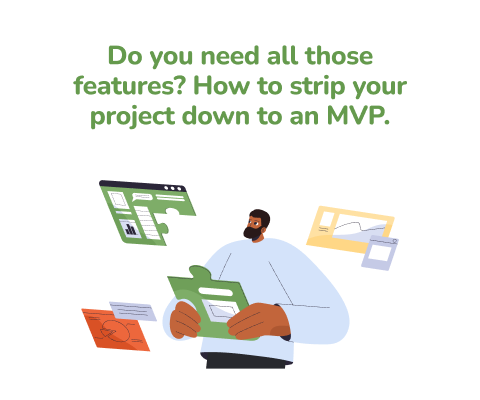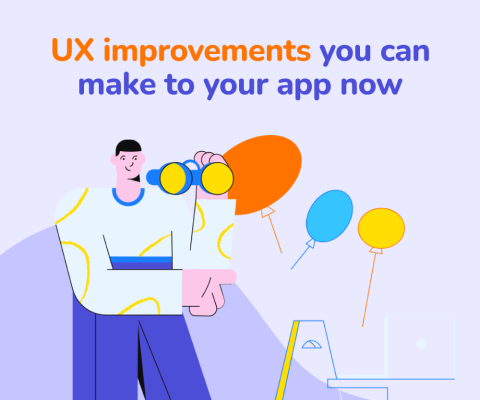January 8th, 2026, posted in for_founders
by Miruna
You build software to solve an issue. To help a group of people find better ways to fulfill their tasks, to contribute to society, to innovate within a specific industry.
As time goes by, people, society, the economy - it all changes. And your app might not. You’d lose customers and wonder, "where's everyone going?”. And the answer is - they’re going where their new needs are met.
Okay so, what does this mean? Once you’ve built an app, you have to maintain it as years go by. And that doesn’t mean just bug fixing and technology updates. Or adding features just for more profits. It means listening to user feedback, watching competitors, and staying up to date & innovative.
This means doing the occasional redesign or design refresh, removing, adding or updating features based on user feedback, and keeping up with industry trends & user needs.
In this article, we’re going to talk about how to build digital products that evolve with user needs - how to detect these needs & how to leverage them in order to improve your software.
What you’re doing wrong when building software
Usually, a big, complex software development project can take years to complete. And a big challenge is staying market-ready despite planning and doing user/market research years before you actually launch.
In other words, you risk building a product that can soon become obsolete, because you focus on launching and profits.
Also, big projects can come with major delays and tech debt. You might hurry to release and in doing so, you might forgo bug fixes in order to reach those deadlines you set for yourself at the beginning.
What happens then? You risk launching a product that doesn’t really work, or which doesn’t truly fulfill user needs - and thus won’t even be used by anyone.
The solution? Here are a few pointers:
- Building user-centric products. By focusing on users and their needs, you get a better shot at reaching your key audience and building a consistent user base.
- Releasing an MVP first. Building a version of your app that only contains essential features is a great way to launch fast, and to test your product before investing years’ worth of money.
- Pay attention to competitors. Someone else might have the same idea, and they might be faster than you. Pay attention to your industry and don’t get discouraged if a similar product comes out before yours - use that as motivation to innovate and improve your own product.
- Don’t rush to launch just for the sake of it. Launching sounds exciting, but putting all your eggs into the launch date basket isn’t that efficient: you’re adding pressure on your team to finish coding, when you could spend that time testing & refining your product so you release it when it’s truly ready and complete.
In other words, building software just for the sake of business and profits can be risky, especially when investing large amounts of money. Since you’re solving issues using software, it’s a much better idea to focus on the people you’re building it for.
The importance of user research
It’s hard to evolve with user needs when you don’t know what said needs are. Generally, when building software - and also while you maintain it over time - it’s good practice to do user research.
Through user research, you can outline a clear audience for your software product, find out what that audience needs, and then figure out the best ways to meet those needs using your software.
You can also use all that data to determine how your audience will develop over time. For instance, if you’re building an educational app for students, you know you need to pay attention to what’s trending for students such as specific tools or apps, and adapt to those trends in order to stay competitive.
Once you’re well established, it’s essential to gauge public opinion on your software: some features might not work anymore, some might be obsolete, or maybe your audience developed new needs that you can cater to.
Here’s how to do user research if you’ve already launched your software:
- Hold focus groups. Gather 5-6 of your app users and ask them how they feel about your app’s features, show them new features you’re proposing and gauge their opinions.
- Send surveys to your users. This is a great way to get feedback, and you can even offer incentives - such as discounts - to users who fill the surveys.
- Read your reviews. If your app is on any kind of app store, chances are you’re getting reviews. Reading and paying attention to this feedback is essential: reviews often contain bug reports.
Through such methods, you can gauge public opinion and adapt your app to their current needs. More so if it took you several years to launch your software, and all your user research was done way before you started coding. It’s no surprise if that research goes out of date.
Use analytics to the fullest
How can you tell you’re not evolving if you don’t pay attention to the state of your software? Well, that’s what analytics are for: either through Google analytics or a third-party analytics app, you can look at your number of visitors, best-performing pages, bounce rate, and so on.
Through such stats, you can see which parts of your app aren’t used as much and can be removed or improved, which parts are underperforming and which are doing well, or even technical stats you might otherwise be overlooking.
Analytics can look specifically at what users do within your software, or even check on your memory, storage or server status. So here is what you can do with this data.
User-based analytics
If you can’t or don’t want to do user research, user-based analytics are a great way to check how people feel about your app. You can see:
- Demographics. Find out where your users are from, their ages and gender. If you’re trying to target a specific demographic, with these stats you can see if you’re actually reaching your target audience or not.
- What parts of your app users enjoy (or not). Analytics platforms track page views and bounce rates, which you can leverage to improve underperforming pages & features.
- Keyword & reference info. A great help when trying to improve your software is seeing how people find it in the first place. You can leverage certain search keywords or platforms that link your software in order to get more clicks.
Technical analytics
It’s not just user data you can get out of analytics apps. When launching a piece of software, you need to be mindful of the fact that it won’t just run perfectly until the end of time. In fact, it’s why you should keep your tech team involved for maintenance.
With technical analytics, you can check:
- Memory and storage stats. Your app’s storage capacity and RAM memory aren’t bottomless pits. When you eventually fill the limits your dev team set, your app might slow down and annoy users.
- Required technology updates. Apps are built using specific programming languages and frameworks, which get regular updates. Keeping your technologies up to date ensures better performance and less bugs.
- Server status. Your server being down means users being unable to do what they need through your app. Pay attention to it and make sure the technology it’s based on is also up to date.
With analytics, you’re getting valuable data you can leverage to improve your software as time goes by. Your stats won’t always be the same, so it’s important to check on your analytics at least once a month. To see a proper evolution, checking every 3 or 6 months can get you valuable insights you can then use to make business decisions.
In-app personalization
If you can’t ask users what they need over time, why not leverage the data they input into your app? In-app personalization is a great way to improve user experience without building complex features, spending time & money on code or doing redesigns.
Through in-app personalization, you’re leveraging user data in order to create a catered experience for each user. If a user often orders from the same restaurants, recommend them to do it again, as a shortcut. If they always request car rides to the same address at the same time of day, give them a notification and pre-build their request before they do.
With such small things, you’re making the user experience more down to earth, friendly and helpful. Plus, you don’t have to regularly interview users to gauge their feedback, as personalization gathers and analyzes user data over time, so it does all of that for you.
You can use in-app personalization to:
- Give users useful shortcuts so they consider your app handy, and they’ll reach for it more often
- Give out notifications with offers the users is likely to be interested in
- Curate content the users are more likely to consume
- Give suggestions based on their app usage
Overall, this is a great method to stay in touch with user needs in a proactive manner. And plus, you don’t have to get directly involved.
Now, a caveat to in-app personalization is privacy: not all users will want you to access their data. In this case, you must give them the option to choose if they agree with it or not. Don’t force it, but do inform them so they know it’s in their best interest.
How to keep your software up to date
Once you’re done building your software and you make your big launch, the work isn’t truly over. You can sit back and relax for a bit, to wait for reviews to come in, and for users to get used to your app.
But after a while, you need to take a careful look at what’s working and what not. What do users like about your app? What are their main complaints? What are their feature requests? What’s making them give up using your software or not use paid features?
Here’s what you can do to evolve your software with user needs:
- Keep an eye on analytics and reviews. Check out actual user feedback as well as analytics. This way, you can get both a subjective and an objective look at what people think about your software.
- Setup refinement cycles every 6 months ish. Once in a while, it’s good practice to start coding new features and improvements. It’s not only good for business goals, but it’s also going to improve user experience and retention.
- Fix bugs & issues your users report. A good way to piss off users is by not fixing major issues they complain about, especially if they do so publicly. It’s a bigger problem if paid features don’t work properly. Pay attention to what users say and take bug reports seriously.
- Pay attention to your industry & competitors. Similar apps to yours might be ahead of you, whether they’ve innovated better or done more user research. Don’t just stand by and watch - use their creativity to get inspired yourself.
Your software won’t evolve with user needs unless you take actions. Sitting and watching passively won’t get you more users or lower your churn rate. Listen to users, stay up to date with industry trends, and actively study how your app is doing.
Looking to build a piece of software that evolves with user needs? Let’s have a chat and create something awesome together.

















